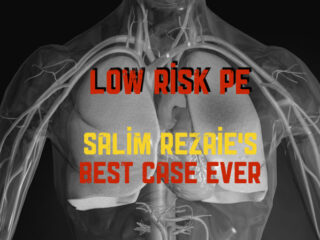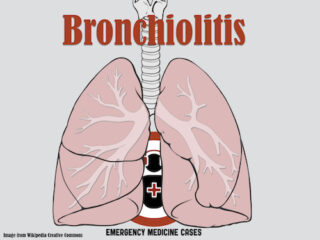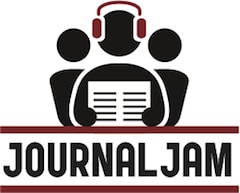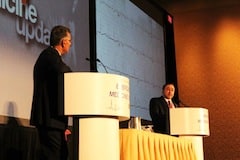Respirology
Best Case Ever 44 Low Risk Pulmonary Embolism
Dr. Salim Rezaie of R.E.B.E.L. EM tells his Best Case Ever of a Low Risk Pulmonary Embolism that begs us to consider a work-up and management plan that we might not otherwise consider. With new guidelines suggesting that subsegmental pulmonary embolism need not be treated with anticoagulants, exceptions to Well's Score and PERC rule to help guide work-ups, the adaptation of outpatient management of pulmonary embolism, and the option of NOACs for treatment, the management of pulmonary embolism in 2016 has evolved considerably. In which situations would you treat subsegmental pulmonary embolism? How comfortable are you sending patients home with pulmonary embolism? How does the patient's values play into these decisions? Listen to Dr. Rezaie provide an insightlful perspective on these important issues and much more...
Episode 59b: Amy Plint on the Management of Bronchiolitis
In response to Episode 59 with Dr. Sanjay Mehta and Dr. Dennis Scolnik on the emergency department diagnosis and management of Bronchiolitis, Dr. Amy Plint, one of Canada's most prominent researchers in Bronchiolitis and the Chair of Pediatric Emergency Research Canada, tells her practical approach to choosing medications in the emergency department, the take home message from her landmark 2009 NEJM study on the use of nebulized epinephrine and dexamethasone for treating Bronchiolitis, and the future of Bronchiolitis research.
Episode 59: Bronchiolitis
This EM Cases episode is on the diagnosis and management of Bronchiolitis. Bronchiolitis is one of the most common diagnoses we make in both general and pediatric EDs, and like many pediatric illnesses, there’s a wide spectrum of severity of illness as well as a huge variation in practice in treating these children. Bronchiolitis rarely requires any work up yet a lot of resources are used unnecessarily. We need to know when to worry about these kids, as most of them will improve with simple interventions and can be discharged home, while a few will require complex care. Sometimes it’s difficult to predict which kids will do well and which kids won’t. Not only is it difficult to predict the course of illness in some of these children but the evidence for different treatment modalities for Bronchiolitis is all over the place, and I for one, find it very confusing. Then there’s the sphincter tightening really sick kid in severe respiratory distress who’s tiring with altered LOC. We need to be confident in managing these kids with severe disease. So, with the help of Dr. Dennis Scolnik, the clinical fellowship program director at Toronto’s only pediatric emergency department and Dr. Sanjay Mehta, an amazing educator who you might remember from his fantastic work on our Pediatric Ortho episode, we’ll sort through how to assess the child with respiratory illness, how to predict which kids might run into trouble, and what the best evidence-based management of these kids is.
Journal Jam 2: Small Bore Chest Tube and Outpatient Management of Pneumothorax
It makes sense that the treatment of primary spnontaneous pneumothorax would lend itself well to outpatient management, since patients are usually young and otherwise healthy, and the mortality and morbidity from these air leaks are really very low. Most patients would rather be managed as an outpatient rather than admitted to hospital and sending these patients home would probably end up saving the system resources and money. In this month's Journal Jam Podcast on small bore chest tube and outpatient management of pneumothorax, the highlighted article that Anton Helman and Teresa Chan discuss is Voison et al. on the “Ambulatory Management of Large Spontaneous Pneumothorax With Pigtail Catheters.” We hear from Michelle Lin, Seth Trueger, Heather Murray and the lead author himself, Stephan Jouneau. Questions posed include: In what ways is the use of small bore catheters with Heimlich valves for spontaneous pneumothorax better than needle aspiration? Is it necessary to repeat a CXR after placement of the catheter? Who should follow up these patients after they are discharged from the hospital? How can we minimize kinking and dislodgement of the catheter? and many more..... [wpfilebase tag=file id=523 tpl=emc-play /] [wpfilebase tag=file id=524 tpl=emc-mp3 /]
Journal Jam 1: Age Adjusted D-dimer with Jeff Kline and Jonathan Kirschner
In this first ever episode of the Journal Jam podcast, a collaboration between EM Cases, Academic Life in EM and The Annals of Emergency Medicine's Global Emergency Medicine Journal Club, Teresa Chan and I, along with Jeff Kline, Jonathan Kirschner, Anand Swaminathan, Salim Rezaie and Sam Shaikh from ALiEM, discuss the potential for Age Adjusted D-dimer to rule out pulmonary embolism in low risk patients over the age of 50. We discuss 4 key questions about the ADJUST-PE Study from JAMA in March 2014 including: Would you order a CTPA on a 60 year old woman with an age adjusted D-dimer of 590 ng/L? The problem until now has been that the older the patient, the more likely the D-dimer is to be positive whether they have a PE or not, so many of us have thrown the D-dimer out the window in older patients and go straight to CTPA, even in low risk patients. If you are a risk averse doc, this strategy will lead to over-utilization of resources, huge costs, length of stay, radiation effects etc; and if you’re not so risk averse, then you might decide not to work up the low risk older patient at all and miss clinically important PEs. expert peer reviewFor all the questions discussed on this podcast, the original Google Hangout interview from which this podcast was based, and the crowd sourced opinions from around world, visit the ALiEM website. Many thanks to all the talented people who made this podcast possible. Together, we're smarter!
Best Case Ever 24: COPD, Baggging and Vent Settings
In anticipation of the Highlights from North York General's Emergency Medicine Update Conference 2014 we have the master educator himself, Dr. Amal Mattu's Best Case ever of a patient who presented with a COPD exacerbation, that we recorded at the conference in Toronto just a couple of weeks ago. Dr. Mattu gives you a string of pearls and pitfalls when it comes to management of COPD, bagging & vent settings that you will never forget. In the upcoming episode Dr. Mattu will review his favorite papers from the cardiology literature of the past year and Dr. Stuart Swadron will give you his approach to the challenges of the patient with vertigo. This will the first of two parts of the highlights from the conference - the largest and best EM conference in Canada.






